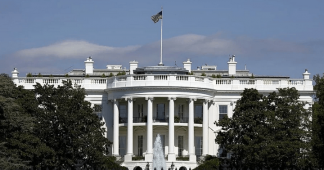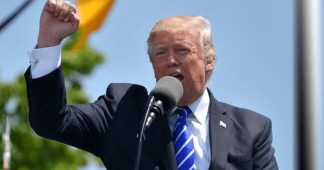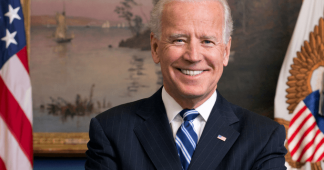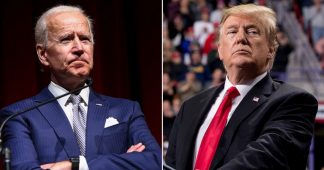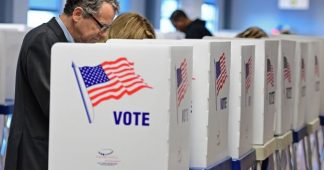With the Trump presidency thankfully in its death throes, Joe Biden and the Democratic leadership are in thrall to a dangerous illusion that they can take the country back to the political world of 2015 as if nothing happened. They’re about to learn that they’ve won a Pyrrhic victory.
By Luke Savage
Nov. 7, 2020
Even before the numbers started looking unexpectedly good for Donald Trump, I knew something must be wrong. The clue was a subtle but real shift in cable news banter, which pivoted early on Tuesday night from its initial tone of self-assurance to one of visible agitation. Joe Biden seemed to be leading in at least a few of the right places, but where was the landslide Democrat-aligned pundits and pollsters alike had confidently suggested was coming? With signs of the promised blowout mysteriously absent, the high priests of cable news gradually seemed to settle on an answer. Sure, Trump might be ahead in key states across the Midwest but this was precisely the outcome we’d all anticipated. Mail-in ballots were forthcoming, after all, and they were likely to break for Biden.
The narrative resonated not only because it was what viewers ill-disposed to Donald Trump wanted to hear, but because it would soon turn out to be true: on Saturday morning, Biden passed the 270 electoral college threshold to win the presidency thanks to the late counting of mail-in ballots breaking strongly in his favor. Nevertheless, the general tone on CNN midway through election night seemed desperate to retain the sense that everything was going according to plan. With the dust finally settling, there’s a good chance this narrative will stick — not only because liberal partisans (and Democratic consultants) will push it, but because it’s what so many political observers and ordinary people beset with Trump fatigue desperately want to believe.
Suffice it to say, this election should never have been close, and things did not, to put it mildly, go according to plan. Though the final tally is yet to come, Trump has added millions of votes to his 2016 total. Give or take a few thousand ballots in a handful of swing states, he’d now be on his way to a second term. This is to say nothing of the Democrats’ catastrophic performance down-ballot, which saw several GOP Senate incumbents swat down cash-soaked challengers and the majority party lose seats in the House only two years after its big 2018 victory. When all is said and done, an election week that began with euphoria about the prospect of the Democrats flipping Texas and securing a comfortable Senate majority ended in heavy breathing as we all reassured ourselves, and each other, that Biden would eventually cross the finish line.
Every electoral result needs to be evaluated in its specific context, and it’s first and foremost the broader political dynamics of 2020 that make this year’s vote such a Pyrrhic victory for both the Biden campaign and the Democratic Party. Trump has never been a popular president. Much of the national media clearly favored a Democratic win. As of late last month, a quarter of a million Americans had died from the coronavirus with millions more plunged into poverty. And yet. Amid widespread economic hardship and a pandemic wreaking havoc on lives and livelihoods throughout America, a historically corrupt, loathed, and scandal-ridden president somehow received millions of additional votes in his bid for reelection. Had the virus never hit and the situation that prevailed in January remained — which saw Trump’s economic approval rating rise to levels not seen by any president for two decades — there can be little doubt that the former host of TV’s The Apprentice would have flattened the hapless Biden on his road to a second term.
In the weeks ahead, we can expect a deluge of self-serving spin riddled with the same tone of defensive reassurance that prevailed on election night. But even as it ultimately delivered the necessary tally in the electoral college, plenty of questions remain about the effectiveness of Biden’s candidacy and the Democratic strategy overall.
First and foremost, the decision to court and foreground Republicans, on full display at this summer’s DNC, appears to have fallen flat on its face. The glorified wallet inspectors at the Lincoln Project may have successfully bilked liberals for tens of millions, but their ads don’t seem to have been any more effective against Trump than the farcical rearguard action undertaken by conservative elites during his initial rise. According to an exit poll published by Edison Research, 93 percent of Republican voters ultimately backed Trump — an even greater proportion than in 2016. Only a few short months ago, Rahm Emanuel, the pied piper of Applebee’s suburbia himself, could be heard calling this the “year of the Biden Republican.” Evidently not.
Its particular visibility this cycle notwithstanding, the strategy was hardly a blip, centrist Democrats having long convinced themselves the country is so inherently conservative that coddling right-leaning voters with appeals to moderation is a stroke of Machiavellian genius rather than a capitulation to post-Reaganite inertia. As in 2016, that assumption seems to have borne little fruit. Across the county, in fact, ballot initiatives and exit polls suggest the Democrats ran to the right of a voting majority on key issues. Florida, the first state to make clear the promised landslide would not be forthcoming, voted by a considerable margin to raise its minimum wage. Ballot measures to legalize marijuana, an idea Biden opposes despite its remarkable popularity across partisan lines, passed in five states. Even with a visibly slanted framing, universal health care scored a resounding 72 percent support in an exit poll commissioned by (of all places) Fox News, which also identified majority backing for stricter gun control, progressive immigration reform, and reproductive rights.
Though a fair amount of revisionism will probably appear in the coming weeks, partisans for the Democrats’ chosen strategy were confidently predicting it would deliver a ’72-style blowout only days ago. “This may be the biggest landslide possible in this polarized country,” Democratic pollster Stan Greenberg told the Daily Beast on October 29. “This thing is not going to be close,” declared James Carville on MSNBC. Still more effusive about Democratic prospects, one October 21 New York Times report anticipated “an ambitious and rare electoral blowout.” Once again, Democrats quite zealously bet the house on a centrist campaign they insisted would deliver a victory of historic proportions. Once again, it failed to yield the promised results — bleeding terrifying numbers of nonwhite voters to the Republican Party in the process.
This brings us to Biden himself, the figure Democratic primary voters were quite sternly told was the safe and electable choice against Donald Trump. Numerous voices on the Left (including many at this magazine) argued vociferously that a popular, majoritarian program targeting traditional nonvoters and seeking to energize the traditional Democratic base represented the better option — both for defeating Trump and turning the tide on decades of liberal retrenchment. Since this theory was never actually tested, we can’t know for certain whether its core assumptions were correct (though my own opinion on the matter should not be difficult to extrapolate).
What we do know is that the standard Democratic playbook has come up short more times than it’s succeeded. Put in the plainest terms, there have only been two Democratic presidents in the past forty years and the more successful of the two ran as a populist outsider declaring himself the leader of a mass movement while pledging to take on Wall Street, dial back America’s involvement in foreign wars, and pursue a transformative course for the country. Biden, despite his close association with Barack Obama, played an active role in entrenching triangulation as the Democratic modus operandi during the 1980s and never wanted to run a campaign of that kind.
Contra the spirit of 2008, the former vice president and soon to be president-elect pitched himself in the most modest of terms: as a figure who would temper the chaos and anarchy of the last four years and restore the country to a pre-2016 equilibrium. Despite innumerable column inches expended on absurd speculation he would champion an ambitious liberal agenda, Biden’s own rhetoric (and corporate donor strategy) has always said otherwise. More mood than mind, his appeal rested, and still rests, on the flawed assumption that Trumpism begins and ends with Donald Trump’s occupancy of the White House — a more conventionally styled and less mercurial president being enough to cure whatever random spasm may have temporarily caused a chunk of the electorate to take leave of its senses.
This small-c conservative approach to national leadership inevitably meant eschewing or marginalizing big policy ideas, even as a deadly virus invaded the body politic. The public option, Biden’s supposedly pragmatic alternative to Medicare for All, scarcely received a mention on the campaign trail. As wildfires burned with apocalyptic ferocity across the West Coast, he offered little but recitation of the empty liberal mantra that climate change is real while actively distancing himself from the most ambitious green program in modern history. Even as Republicans made a deadly power grab in the Supreme Court, Biden took care during his first debate with Trump to offer kind words about the president’s hard-right nominee and rejected calls for judicial reform.
This is to say nothing of Biden’s personal weaknesses as a candidate, generally elided by a mostly sympathetic commentariat content to bury or spin its wheels on stories or incidents that might put his prospects in jeopardy. Thus, even Biden’s penchant for keeping a low profile and running an absentee campaign throughout parts of September seemed to elicit none of the obvious questions and even earned occasional praise. That the former vice president has lately sounded nothing like the man who so ably debated Paul Ryan in 2012 has largely been pushed from the official narrative altogether.
Biden’s candidacy notwithstanding, the Democrats’ lackluster election results were not inevitable but the product of freely made political choices and calculations. Predictably enough, key party figures and media surrogates are already working to place the blame elsewhere. Former senator Claire McCaskill apparently believes the Democrats talk in excess about guns, reproductive rights, gay marriage, “and rights for transexuals.” With Senate runoffs looming in Georgia, House Majority Whip Jim Clyburn, meanwhile, reportedly declared on a caucus call, “[if] we are going to run on Medicare for All, defund the police, [and] socialized medicine, we’re not going to win.” Nancy Pelosi is similarly warning Democrats not to move to the left. Needless to say, these are puzzling reactions from figures whose own preferred strategy has so resoundingly failed to deliver its promised result. As the electoral dust settles, we will inevitably be treated to a growing chorus of voices from across the liberal establishment who will insist that the only path forward for Democrats is some noxious mix of economic and cultural revanchism. The liberal center, ever convinced of its own savvy rectitude, paradoxically discovers validation even in moral and tactical defeat.
This state of affairs will lamentably redound to all of Biden’s worst instincts as a lifelong fetishist of bipartisan compromise and elite brokerage. Assuming Republicans retain the Senate, America will be led by a de facto McConnell/Biden coalition government throughout a period of spiraling deficits and growing calls for austerity. Those who prayed for Trump’s banishment and a return to the Obama era may therefore be getting their wish, albeit as if granted by black magic via the cursed monkey’s paw: a centrist president, a divided Congress, and an obstructionist Senate. A return to normalcy at last.
Thankfully, the Trump presidency is about to die the pathetic, spluttering death it so richly deserves — leaving behind it a legacy of lies, larcenous tax cuts, and needless cruelty. Yet despite the anarchy it has undeniably wrought, the concluding theme of the Trump era may end up being continuity more than disruption. When the charade of Trump’s final weeks in office is finally behind us, the landscape of American politics will look much like a version of early 2016 with a handful of contrasts both bright and bleak.
If the past week is any indication, nothing about the underlying strategic calculus of the two party leaderships promises to exhibit much change beyond the aesthetic. Democrats will dither and offer concessions, celebrating every retreat as a victory for “incrementalism.” Mitch McConnell will obstruct and, where possible, draw legislative blood as only he can. The ossified post-2010 consensus will stubbornly persist as elites retain their crippling addictions to triangulation and the vices of organized wealth.
If Trumpism once promised to tear political normalcy asunder, the president will leave office as a conventional creature of the conservative apparatus through and through — his bad manners and unhinged personality largely adornments to the usual GOP agenda of race-baiting and upward redistribution to the extremely rich. Establishment Democrats, meanwhile, brought a genuine insurgency to a heel, defeating Bernie Sanders and disciplining their own base with an effectiveness that would be impressive if it weren’t so contemptible. With Biden, the great tranquilizer, poised to enter the White House, the deep and abiding conservatism of America’s most powerful liberals will only grow more apparent.
Nevertheless, there remain genuine signs of hope. Buoyed by important congressional victories in New York, Michigan, Minnesota, and Missouri, the insurgent left now counts more elected officials in its ranks than at any other moment in modern history. This summer’s historic protests against police violence, and the widespread support they received, give lie to the idea of an irredeemably conservative country — as do a slew of ballot initiatives and exit polls suggesting a continued hunger for an alternative to the paltry bipartisan fare currently on offer.
The Trump presidency will soon be over. For better and for worse, politics are here to stay
Published at www.jacobinmag.com
